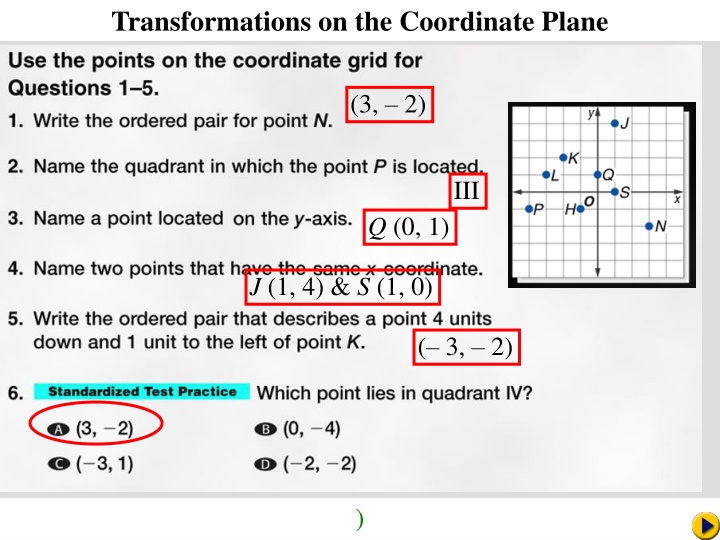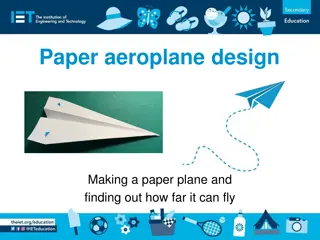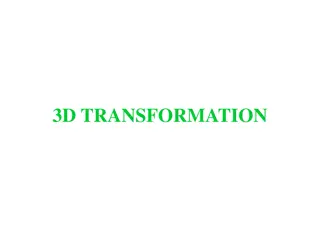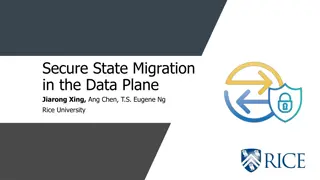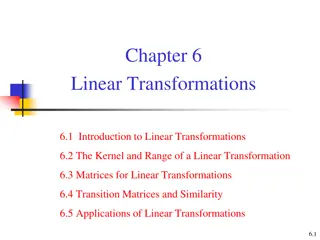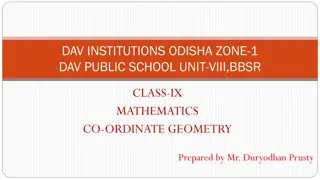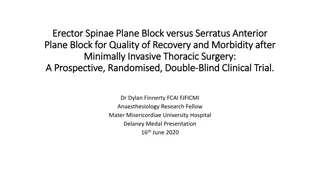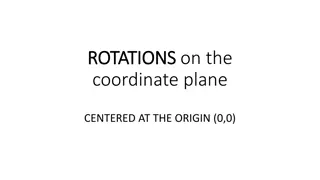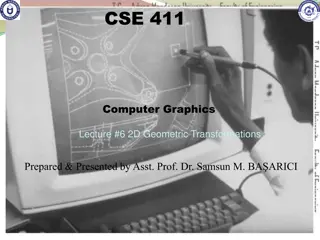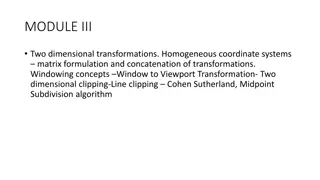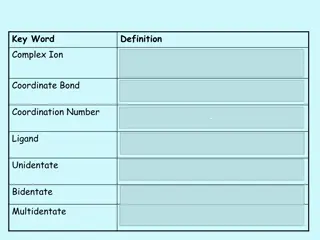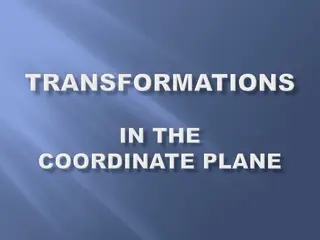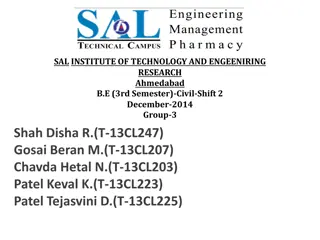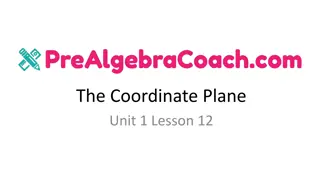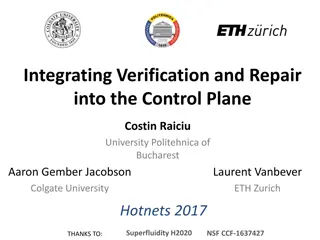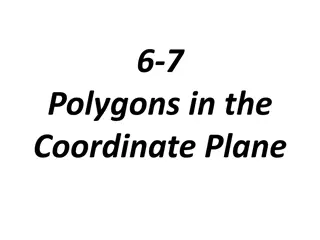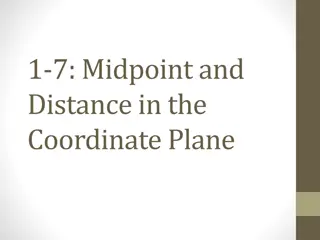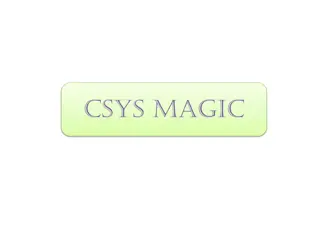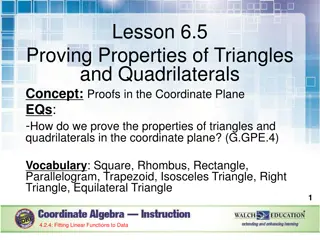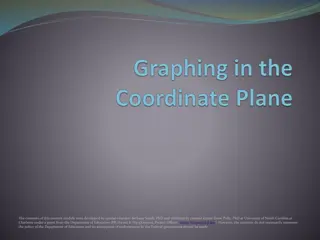Transformations on the Coordinate Plane
Transformations on the coordinate plane involve movements of geometric figures through reflections, translations, dilations, and rotations. By identifying each transformation correctly, you can understand how figures shift, expand, or rotate in relation to a given point or line.
Download Presentation

Please find below an Image/Link to download the presentation.
The content on the website is provided AS IS for your information and personal use only. It may not be sold, licensed, or shared on other websites without obtaining consent from the author.If you encounter any issues during the download, it is possible that the publisher has removed the file from their server.
You are allowed to download the files provided on this website for personal or commercial use, subject to the condition that they are used lawfully. All files are the property of their respective owners.
The content on the website is provided AS IS for your information and personal use only. It may not be sold, licensed, or shared on other websites without obtaining consent from the author.
E N D
Presentation Transcript
Transformations on the Coordinate Plane (3, 2) III Q (0, 1) J (1, 4) & S (1, 0) ( 3, 2) ) next
Transformations on the Coordinate Plane Transformations are movements of geometric figures. The preimage is the position of the figure before the transformation, and the image is the position of the figure after the transformation. back next
Transformations on the Coordinate Plane back next
Transformations on the Coordinate Plane Reflection: a figure is flipped over a line Translation: a figure is slid in any direction Dilation: a figure is enlarged or reduced Rotation: a figure is turned around a point back next
Identify Transformations Identify the transformation as a reflection, translation, dilation, or rotation. Answer: The figure has been increased in size. This is a dilation. back next
Identify Transformations Identify the transformation as a reflection, translation, dilation, or rotation. Answer: The figure has been shifted horizontally to the right. This is a translation. back next
Identify Transformations Identify the transformation as a reflection, translation, dilation, or rotation. Answer: The figure has been turned around a point. This is a rotation. back next
Identify Transformations Identify the transformation as a reflection, translation, dilation, or rotation. Answer: The figure has been flipped over a line. This is a reflection. back next
Identify Transformations Identify each transformation as a reflection, translation, dilation, or rotation. a. b. Answer: reflection Answer: rotation d. c. Answer: translation Answer: dilation back next
Transformations on the Coordinate Plane back next
Reflection A trapezoid has vertices W( 1, 4), X(4, 4), Y(4, 1) and Z( 3, 1). Trapezoid WXYZ is reflected over the y-axis. Find the coordinates of the vertices of the image. To reflect the figure over the y-axis, multiply each x-coordinate by 1. Answer: The coordinatesof the (x, y) ( x, y) (1, 4) ( 4, 4) ( 4, 1) (3, 1) verticesof the image are W (1, 4), X ( 4, 4), Y ( 4, 1), and Z (3, 1). W( 1, 4) X(4, 4) Y(4, 1) Z( 3, 1) back next
Reflection A trapezoid has vertices W( 1, 4), X(4, 4), Y(4, 1), and Z( 3, 1). Graph trapezoid WXYZ and its image W X Y Z . Answer: Graph each vertex of the trapezoid WXYZ. Connect the points. X W W X Graph each vertex of the reflected image W X Y Z . Connect the points. Y Z Z Y back next
Reflection A parallelogram has vertices A( 4, 7), B(2, 7), C(0, 4) and D( 2, 4). a. Parallelogram ABCD is reflected over the x-axis. Find the coordinates of the vertices of the image. Answer: A ( 4, 7), B (2, 7), C (0, 4), D ( 2, 4) back next
Reflection b. Graph parallelogram ABCD and its image A B C D . Answer: back next
Transformations on the Coordinate Plane back next
Translation Triangle ABC has vertices A( 2, 1), B(2, 4), and C(1, 1). Find thecoordinates of the vertices of the image if it is translated 3 units to the right and 5 units down. To translate the triangle 3 units to the right, add 3 to the x-coordinate of each vertex. To translate the triangle 5 units down, add 5 to the y-coordinate of each vertex. Answer: The coordinates of the vertices of the image are A (1, 4), B (5, 1), and C (4, 4). back next
Translation Graph triangle ABC and its image. Answer: B The preimage is . A The translated image is C B A C back next
Translation Triangle JKL has vertices J(2, 3), K(4, 0), and L(6, 3). a. Find the coordinates of the vertices of the image if it is translated 5 units to the left and 2 units up. Answer: J ( 3, 1), K ( 1, 2), L (1, 1) b. Graph triangle JKL and its image. Answer: back next
Transformations on the Coordinate Plane back next
Dilation A trapezoid has vertices E( 1, 2), F(2, 1), G(2, 1), and H( 1, 2). Find the coordinates of the dilated trapezoid E F G H if the scale factor is 2. To dilate the figure, multiply the coordinates of each vertex by 2. Answer: The coordinates of the vertices of the image are E ( 2, 4), F (4, 2), G (4, 2), and H ( 2, 4). back next
Dilation Graph the preimage and its image. Answer: E The preimage is trapezoid EFGH. The image is trapezoid E F G H . F E F G Notice that the image has sides that are twice the length of the sides of the original figure. G H H back next
Dilation A trapezoid has vertices E( 4, 7), F(2, 7), G(0, 4), and H( 2, 4). a. Find the coordinates of the dilated trapezoid E F G H if the scale factor is Answer: back next
Dilation b. Graph the preimage and its image. Answer: back next
Transformations on the Coordinate Plane back next
Rotation Triangle ABC has vertices A(1, 3), B(3, 1), and C(5, 2). Find the coordinates of the image of ABC after it is rotated180 about the origin. To find the coordinates of the image of ABC after a 180 rotation, multiply both coordinates of each point by 1. Answer: The coordinates of the vertices of the image are A ( 1, 3), B ( 3, 1), and C ( 5, 2). back next
Rotation Graph the preimage and its image. Answer: A C The preimage is . B The translated image is B C A back next
Rotation Triangle RST has vertices R(4, 0), S(2, 3), and T(6, 3). a. Find the coordinates of the image of RST after it is rotated 90 counterclockwise about the origin. Answer: R (0, 4), S (3, 2), T (3, 6) b. Graph the preimage and theimage. Answer: back next
